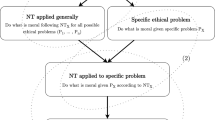Abstract
This paper challenges two orthodox theses: (a) that computational processes must be algorithmic; and (b) that all computed functions must be Turing-computable. Section 2 advances the claim that the works in computability theory, including Turing's analysis of the effective computable functions, do not substantiate the two theses. It is then shown (Section 3) that we can describe a system that computes a number-theoretic function which is not Turing-computable. The argument against the first thesis proceeds in two stages. It is first shown (Section 4) that whether a process is algorithmic depends on the way we describe the process. It is then argued (Section 5) that systems compute even if their processes are not described as algorithmic. The paper concludes with a suggestion for a semantic approach to computation.
Similar content being viewed by others
References
Amit, D. (1989), Modeling Brain Function, Cambridge: Cambridge University Press.
Block, N. and Fodor, J.A. (1972), ‘Cognitivism and the Analog/Digital Distinction’, unpublished manuscript.
Church, A. (1936a), ‘An Unsolvable Problem of Elementary Number Theory’, Am. J. Math., 58 pp. 345–363. Reprinted in Davis (1965), pp. 88–107.
Church, A. (1936b), ‘A Note on the Entscheidungsproblem’, Journal of Symbolic Logic, 1, pp. 40–41. Reprinted in Davis (1965), pp. 108–115.
Churchland, P.S. and Sejnowski, T. (1992), The Computational Brain, Cambridge, MA: The MIT Press.
Cleland, C. (1993), ‘Is the Church–Turing Thesis True?’, Minds and Machines, 3, 283–312.
Cummins, R. (1989), Meaning and Mental Represenation, Cambridge, MA: The MIT Press.
Cummins R. and Schwarz G. (1991), ‘Connectionism, Computation, and Cognition’, in Horgan, T. and Tienson, J. (eds.), Connectionism and the Philosophy of Mind, Dordrecht: Kluwer, pp. 60–73.
Davis, M. (ed.) (1965), The Undecidable: Basic Papers on Undecidable Propositions, Unsolvable Problems and Computable Functions, New-York: Raven.
Demopoulos, W. (1987), ‘On Some Fundamental Distinctions of Computationalism’, Synthese, 70, pp. 79–96.
Dietrich, E. (1990), ‘Computationalism’, Social Epistemology, 4, pp. 135–154.
Earman, J. (1986), A Primer for Determinism, Holland: D. Reidel.
Fetzer, J.H. (1994), ‘Mental Algorithms: Are Minds Computational Systems?’, Pragmatics and Cognition, 2, pp. 1–29.
Gandy, R.O. (1980), ‘Church's Thesis and Principles of Mechanisms’, in Barwise J., Keisler J.J. and Kunen K. (eds.), The Kleene Symposium, Amsterdam: North-Holland, pp. 123–145.
Gandy R.O. (1988), ‘The Confluence of Ideas in 1936’, in Herken, R. (1988), pp. 55–11l.
Gödel, K. (1931), ‘Uber formal unentscheidbare Satze der Principia Mathematica und verwandter Systeme I’, J. Monast. Math. Ph., 38, pp. 173–198. Translated and reprinted in Davis (1965), pp. 4–38.
Gödel, K. (1946), ‘Remarks before the Princeton Bicentennial Conference on Problems in Mathematics’, Reprinted in Davis (1965), pp. 84–88.
Goel, V. (1991), ‘Notationality and the Information-Processing Mind’, Minds and Machines, 1, pp. 129–165.
Goodman, N. (1968), Languages of Art, Indianapolis: Bobbs-Merrill.
Grzegorczyk, A. (1955), ‘Computable Functionals’, Fund. Math., 42, pp. 168–202.
Grzegorczyk, A. (1957), ‘On the Definitions of Computable Real Continuous Functions’, Fund. Math., 44, pp. 61–71.
Haugeland, J. (1981), ‘Analog and Analog’, Philosophical Topics, 12, pp. 213–225.
Herken, R. (ed.) (1988), The Universal Turing-Machine, A Half-Century Survey, Oxford: Oxford University Press.
Hilbert, D. and Ackermann, W. (1928), Grundzuge der Theoretischen Logic, Berlin.
Hopfield, J.J. (1982), ‘Neural Networks and Physical Systems with Emergent Collective Computational Abilities’, Proceedings of the National Academy of Science, USA, 79, pp. 2554–2556.
Kleene, S.C. (1936a), ‘General Recursive Functions of Natural Numbers’, Math. Annal., 112, pp. 727–742. Reprinted in Davis (1965), pp. 236–253.
Kleene, S.C. (1936b), ‘⋋-definability and Recursiveness’, Duke Math. J., 2, pp. 340–353.
Kleene, S.C. (1988), ‘Turing's Analysis of Computability, and Major Applications of It’, in Herken (1988), pp. 17–54.
Lewis, D. (1971), ‘Analog and Digital’, Noûs, 5, pp. 321–327.
Morris, P., (1991), ‘On the Density of Solutions in Equilibrium Points for the N-Queens Problem’, Technical Note TR-M 91–2.
Penrose, R.; (1989), The Emperor's New Mind, Oxford: Oxford University Press.
Penrose, R. (1994), Shadows of the Mind, Oxford: Oxford University Press.
Pitowsky, I. (1990), ‘The Physical Church Thesis and Physical Computational Complexity’, lyuum, A Jerusalem Philosophical Quarterly, 39, pp. 81–99.
Post, E.L. (1936), ‘Finite Combinatory Processes – Formulation I’, Journal of Symbolic Logic, 1, pp. 103–105. Reprinted in Davis (1965), pp. 288–291.
Pour-El, M.B. (1974), ‘Abstract Computability and its Relation to the General Purpose Analog Computer’, Trans. Amer. Math. Soc., 199, pp, 1–29.
Pour-El, M.B. and Caldwell, J. (1975), ‘On a Simple Definitions of Computable Functions of a Real Variable with Applications to Functions of a Complex Variable’, Z. Math. Logik. Grundlagen Math., 21, pp. 1–19.
Pour-El, M.B. and Richards, I. (1981), ‘The Wave Equation with Computable Initial Data such that its Unique Solution is not Computable’. Adv. in Math., 39, pp. 215–239.
Pylyshyn, Z.W. (1984), Computation and Cognition, Cambridge, MA: The MIT Press.
Shagrir, O., (1992), ‘ANeuralNet with Self InhibitingUnits for the N-Queens Problem’, International Journal of Neural Systems, 3, 349–352.
Shapiro, S. (1983), ‘Remarks on the Development of Computability’, History and Philosophy of Logic, 4, pp. 203–220.
Sieg, W. (1994), ‘Mechanical Procedures and Mathematical Experience’, in George, A. (ed.), Mathematics and Mind, Oxford: Oxford University Press, pp. 71–114.
Sosic, R. and Gu, J., (1990), ‘A Polynomial Time Algorithm for the N-Queens Problem’, SIGART Bulletin, 1, pp. 7–11.
Sosic, R. and Gu, J., (1991), ‘3,000,000 Queens in Less Than One Minute’, SIGART Bulletin, 2, pp. 22–24.
Turing, A.M. (1936–7), ‘On Computable Numbers, with an Application to theEntscheidungsproblem’, P. Lond. Math. Soc. (2), 42 (1936), pp. 230–265. plus a correction, ibid., 43 (1937), pp. 544–546. Reprinted in Davis (1965), pp. 115–154.
Turing, A. (1950), ‘Computing, Machinery, and Intelligence’, Mind, 59, 433–460
van Heijenoort, J., (1967), From Frege to Gödel: A Source Book in Mathematical Logic 1879–1931, Cambridge, MA: Harvard University Press.
Author information
Authors and Affiliations
Rights and permissions
About this article
Cite this article
Shagrir, O. Two Dogmas of Computationalism. Minds and Machines 7, 321–344 (1997). https://doi.org/10.1023/A:1008236522699
Issue Date:
DOI: https://doi.org/10.1023/A:1008236522699




